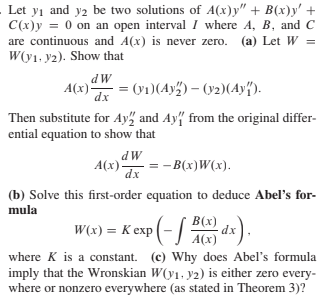Let yı and y2 be two solutions of A(x)y" + B(x)y' + C(x)y = 0 on an open interval I where A, B, and C are continuous and A(x) is never zero. (a) Let W = W(y1. y2). Show that A(x) dx = (y1)(4y%) – (y2)(4y“). Then substitute for Ay, and Ay{ from the original differ- ential equation to show that A(x). dx - B(x)W(x). (b) Solve this first-order equation to deduce Abel's for- mula W(x) = K exp (- / dx). A(x) where K is a constant. (c) Why does Abel's formula imply that the Wronskian W(y1. y2) is either zero every- where or nonzero everywhere (as stated in Theorem 3)?
Let yı and y2 be two solutions of A(x)y" + B(x)y' + C(x)y = 0 on an open interval I where A, B, and C are continuous and A(x) is never zero. (a) Let W = W(y1. y2). Show that A(x) dx = (y1)(4y%) – (y2)(4y“). Then substitute for Ay, and Ay{ from the original differ- ential equation to show that A(x). dx - B(x)W(x). (b) Solve this first-order equation to deduce Abel's for- mula W(x) = K exp (- / dx). A(x) where K is a constant. (c) Why does Abel's formula imply that the Wronskian W(y1. y2) is either zero every- where or nonzero everywhere (as stated in Theorem 3)?
Calculus: Early Transcendentals
8th Edition
ISBN:9781285741550
Author:James Stewart
Publisher:James Stewart
Chapter1: Functions And Models
Section: Chapter Questions
Problem 1RCC: (a) What is a function? What are its domain and range? (b) What is the graph of a function? (c) How...
Related questions
Question

Transcribed Image Text:Let yı and y2 be two solutions of A(x)y" + B(x)y' +
C(x)y = 0 on an open interval I where A, B, and C
are continuous and A(x) is never zero. (a) Let W =
W(y1. y2). Show that
A(x)
dx
= (y1)(4y%) – (y2)(4y“).
Then substitute for Ay, and Ay{ from the original differ-
ential equation to show that
A(x).
dx
- B(x)W(x).
(b) Solve this first-order equation to deduce Abel's for-
mula
W(x) = K exp (- / dx).
A(x)
where K is a constant. (c) Why does Abel's formula
imply that the Wronskian W(y1. y2) is either zero every-
where or nonzero everywhere (as stated in Theorem 3)?
Expert Solution
This question has been solved!
Explore an expertly crafted, step-by-step solution for a thorough understanding of key concepts.
This is a popular solution!
Trending now
This is a popular solution!
Step by step
Solved in 8 steps with 8 images

Recommended textbooks for you

Calculus: Early Transcendentals
Calculus
ISBN:
9781285741550
Author:
James Stewart
Publisher:
Cengage Learning

Thomas' Calculus (14th Edition)
Calculus
ISBN:
9780134438986
Author:
Joel R. Hass, Christopher E. Heil, Maurice D. Weir
Publisher:
PEARSON

Calculus: Early Transcendentals (3rd Edition)
Calculus
ISBN:
9780134763644
Author:
William L. Briggs, Lyle Cochran, Bernard Gillett, Eric Schulz
Publisher:
PEARSON

Calculus: Early Transcendentals
Calculus
ISBN:
9781285741550
Author:
James Stewart
Publisher:
Cengage Learning

Thomas' Calculus (14th Edition)
Calculus
ISBN:
9780134438986
Author:
Joel R. Hass, Christopher E. Heil, Maurice D. Weir
Publisher:
PEARSON

Calculus: Early Transcendentals (3rd Edition)
Calculus
ISBN:
9780134763644
Author:
William L. Briggs, Lyle Cochran, Bernard Gillett, Eric Schulz
Publisher:
PEARSON

Calculus: Early Transcendentals
Calculus
ISBN:
9781319050740
Author:
Jon Rogawski, Colin Adams, Robert Franzosa
Publisher:
W. H. Freeman


Calculus: Early Transcendental Functions
Calculus
ISBN:
9781337552516
Author:
Ron Larson, Bruce H. Edwards
Publisher:
Cengage Learning